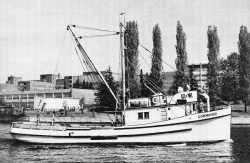
To understand how Puget Sound has changed, we first must understand how it used to be. Unlike most major estuaries in the U.S. — and despite the abundance of world-class oceanographic institutions in the area — long-term monitoring of Puget Sound fish populations did not exist until 1990. Filling in this missing information is essential to establishing a baseline that would provide context for the current status of the marine ecosystem, and could guide policymakers in setting more realistic ecosystem-based management recovery targets.
Researchers from the University of Washington School of Aquatic and Fishery Sciences, UW Puget Sound Institute, NOAA’s Northwest Fisheries Science Center and Washington Department of Fish and Wildlife have discovered an unconventional way to help fill in these gaps in data: using old vessel logbooks.
The crews of the University of Washington’s then School of Fisheries’ research vessels R/V Oncorhynchus (1947 to 1955) and R/V Commando (1955 to 1980), both of which were skippered by Tom Oswold, took notes on all of the fish tows conducted under their watch. With funding from Washington Sea Grant, the researchers combed through more than 1,000 of these logbook entries to analyze the information regarding the groundfish species caught in each tow, including when and where the fish were caught. Then, the researchers analyzed historical logbook data from 1948 to 1977 and contemporary monitoring data to reveal longer-term trends in the local groundfish populations. The research was published in Marine Ecology Progress Series last month.
Although there were changes throughout the periods analyzed, the researchers did not find that groundfish populations today in Puget Sound look fundamentally different from the historical populations.
“We see the same types of fluctuations in the historical data as in the contemporary data,” said Tim Essington, professor at the School of Aquatic and Fishery Sciences and the study’s lead author. “This suggests that boom and bust populations are natural, and speaks to the importance of having a long time view to establishing a baseline.”
Read more at UW News »
